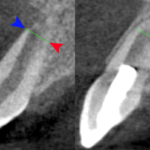
Good success rates have been reported with mineral trioxide aggregate apical plug (MAP) and regenerative endodontic treatment (RET) for the treatment of immature teeth with pulp necrosis. The MAP technique is considered to facilitate an apical seal but not promote root development. With RET there is an intention to regenerate the pulp-dentin complex and promote root thickening and normal maturation of the root apex.
The aim of this review was to assess the evidence for mineral trioxide aggregate (MTA) apical plug (MAP) and regenerative endodontic treatment (RET) in the treatment of teeth with pulp necrosis and open apices.
Methods
Searches were conducted in the Medline/PubMed, Web of Science, and the Cochrane Library databases. Comparative, non-comparative, prospective, and retrospective clinical studies on immature teeth with pulp necrosis treated with RET or MAP were considered. Two reviewers selected studies for inclusion. Data was abstracted and study quality assessed. Clinical trials were also assessed using the Cochrane risk of bias tool with observational studies being assessed using a modified version of the National Institutes for Health tool for observational cohort and cross-sectional studies.
Survival was defined as a retained tooth in the oral cavity at follow-up. Success was defined as a lack of clinical symptoms (ie, pain on percussion/palpation/function or sinus tract) and complete radiographic healing of the periapical lesion. Reduction in the size of the periapical lesion was classified as ‘uncertain.’ The rate of root development was extracted from RET studies. Root development was defined as increased root length, increased root thickness, or reduced apical diameter.
Results
- 144 studies met the inclusion criteria.
- 61 studies involved MAP and 85 RET (2 studies involving both).
- 543 teeth were included in the MAP studies (sample sizes 1-91)
- 455 teeth were included in the RET studies (sample sizes 1-35)
- Crown discoloration was the main treatment complication being reported in 13 (21%) studies in the MAP group and 33 studies (40%) in the RET group.
- 10 clinical trials were included in a meta-analysis.
- There was no statistical difference in success or survival rates between MAP and RET
| MAP group (95% CI) | RET group (95% CI) | |
| Survival rate | 97.1% (93.7–100) | 97.8% (94.8–100) |
| Success rate | 94.6% (90.2–99.1) | 91.3% (84.5–98.2) |
Conclusions
The authors concluded: –
The existing literature lacks high-quality studies with a direct comparison of outcomes of MAP and RET. Randomized multi-centre clinical trials with large sample sizes and long-term follow-ups are needed to address this gap in knowledge.
Comments
This review covers similar ground to one we highlighted last week (Dental Elf – 15th Sept 2017). However, the authors have chosen to use broader inclusion criteria and have also included case reports and case series. Consequently, the bulk of the included studies , 72% in the MAP group and 86% in the RET group come from these study designs, which only provide very low-quality evidence. Only 2 studies compared MAP and RET, one was a clinical trial which found on significant difference the other was a a retrospective cohort compared.
As with the earlier review these findings highlight that only low-quality evidence is available for the effectiveness of MAP and RET for the treatment of teeth with pulp necrosis and open apices. So as the authors recommend high quality well reported multi-centre randomised controlled trials with large sample sizes and long-term follow-ups are needed to address this gap in knowledge.
Links
Primary paper
Torabinejad M, Nosrat A, Verma P, Udochukwu O. Regenerative Endodontic Treatment or Mineral Trioxide Aggregate Apical Plug in Teeth with Necrotic Pulps and Open Apices: A Systematic Review and Meta-analysis. J Endod. 2017 Aug 16.pii: S0099-2399(17)30816-6. doi: 10.1016/j.joen.2017.06.029. [Epub ahead of print] Review. PubMed PMID: 28822564.
Other references
Dental Elf – 15th Sept 2017
Picture Credits
